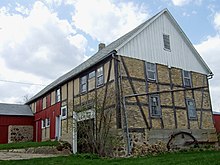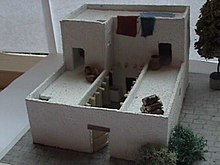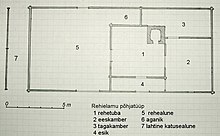
A barn is an agricultural building usually on farms and used for various purposes. In North America, a barn refers to structures that house livestock, including cattle and horses, as well as equipment and fodder, and often grain. As a result, the term barn is often qualified e.g. tobacco barn, dairy barn, cow house, sheep barn, potato barn. In the British Isles, the term barn is restricted mainly to storage structures for unthreshed cereals and fodder, the terms byre or shippon being applied to cow shelters, whereas horses are kept in buildings known as stables. In mainland Europe, however, barns were often part of integrated structures known as byre-dwellings. In addition, barns may be used for equipment storage, as a covered workplace, and for activities such as threshing.

Bastel, bastle, or bastille houses are a type of construction found along the Anglo-Scottish border, in the areas formerly plagued by border reivers. They are fortified farmhouses, characterised by security measures against raids. Their name is said to derive from the French word "bastille".
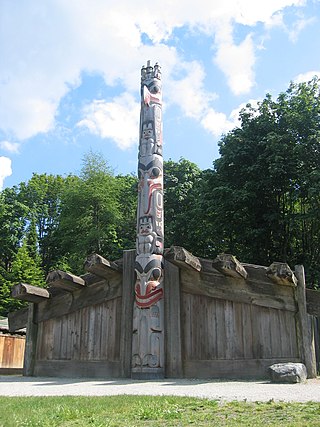
A longhouse or long house is a type of long, proportionately narrow, single-room building for communal dwelling. It has been built in various parts of the world including Asia, Europe, and North America.

The Dartmoor longhouse is a type of traditional stone-built home, typically found on the high ground of Dartmoor, in Devon, England and belonging to a wider tradition of combining human residences with those of livestock under a single roof specific to western Britain; Wales, Cornwall and Devon, where they are more usually referred to simply as longhouses and in general housebarns.
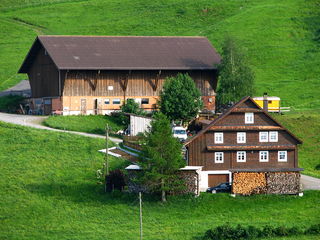
A farmhouse is a building that serves as the primary quarters in a rural or agricultural setting. Historically, farmhouses were often combined with space for animals called a housebarn. Other farmhouses may be connected to one or more barns, built to form a courtyard, or with each farm building separate from each other.

A connected farm is an architectural design common in the New England region of the United States, and England and Wales in the United Kingdom. North American connected farms date back to the 17th century, while their British counterparts have also existed for several centuries. New England connected farms are characterized by a farm house, kitchen, barn, or other structures connected in a rambling fashion. This style evolved from carrying out farm work while remaining sheltered from winter weather. In the United Kingdom there are four distinct types of connected farmsteads, all dissimilar to the New England style.

The Low German house or Fachhallenhaus is a type of timber-framed farmhouse found in northern Germany and the easternmost Netherlands, which combines living quarters, byre and barn under one roof. It is built as a large hall with bays on the sides for livestock and storage and with the living accommodation at one end.
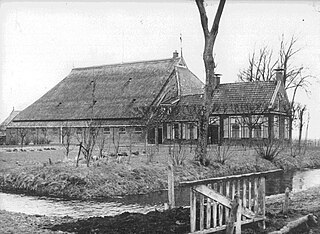
A "Head-Neck-Body farmhouse" or Head-Neck-Rump farmhouse is a typical Frisian farmhouse. It consists of a residence and a kitchen placed in line in front of a big shed. A striking fact is that the residence was never built in the centre front of the shed – this has to do with the origin of this type of farmhouse from a smaller type of farmhouse that has now disappeared. This original Old Frisian longhouse consisted of a residence with a cattle shed immediately behind it. The harvest was stacked in the attic or in open barns which were logically located near the livestock shed.
Old Frisian longhouses were, as the name indicates, long-bodied houses which can be found in the Dutch province Friesland. This type of house had more than two different parts behind or beside each part. It is the forerunner of the "Head-Neck-Body farmhouse".
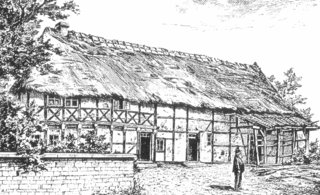
The Middle German house is a style of traditional German farmhouse which is predominantly found in Central Germany.

An Old Frisian farmhouse is a small unit farmhouse (Wohnstallhaus) that combined the farmer's living area and animals' stalls, and had limited space for storing harvest products. It was widely distributed across the North German Plain until the middle of the 17th century and was the forerunner of the Gulf house.

A Gulf house, also called a Gulf farmhouse (Gulfhof) or East Frisian house (Ostfriesenhaus), is a type of byre-dwelling that emerged in the 16th and 17th centuries in North Germany. It is timber-framed and built using post-and-beam construction. Initially Gulf houses appeared in the marshes, but later spread to the Frisian geest. They were distributed across the North Sea coastal regions from West Flanders through the Netherlands, East Frisia and Oldenburg as far as Schleswig-Holstein. This spread was interrupted by the Elbe-Weser Triangle which developed a type of Low German house instead, better known as the Low Saxon house.
The Geestharden house, also called the Cimbrian house, Schleswig house, Slesvig house or Southern Jutland house due to its geographical spread in Jutland, is one of three basic forms on which the many farmhouse types in the north German state of Schleswig-Holstein are based. The other two basic designs are the Gulf house and the Low German hall house. By far the best known variant of the Geestharden house is the Uthland-Frisian house, which is also referred to as the Frisian house (Friesenhaus).

The Uthland-Frisian house, a variation of the Geestharden house, is a type of farmhouse that, for centuries, dominated the North Frisian Uthlande, that is the North Frisian Islands, the Halligen and the marshlands of northwest Germany.
There are several types of Frisian houses in the Netherlands as well as in Germany.

A byre-dwelling is a farmhouse in which the living quarters are combined with the livestock and/or grain barn under the same roof. In the latter case, the building is also called a housebarn in American English.

The Black Forest house is a byre-dwelling that is found mainly in the central and southern parts of the Black Forest in southwestern Germany. It is characterised externally by a long hipped or half-hipped roof that descends to the height of the ground floor. This type of dwelling is suited to the conditions of the Black Forest: hillside locations, broad tracks, high levels of snowfall and heavy wind loading. Individual farms, such as the Hierahof near Kappel, which are still worked today, are over 400 years old. The Black Forest house is described by Dickinson as very characteristic of the Swabian farmstead type.

The Lorraine house or Lorraine farmhouse is a vernacular, agricultural house type found in Lorraine in France and the western part of the Saarland in Germany. It is a byre-dwelling, with the living and working quarters of a farming business combined under one roof. Lorraine houses developed after the devastating wars of the 17th century and took the place of individual scattered farmsteads.

The Bregenzerwälderhaus, Bregenzerwaldhaus or Wälderhaus is a house type from the Bregenz Forest region in Vorarlberg (Austria).

An outbuilding, sometimes called an accessory building or a dependency, is a building that is part of a residential or agricultural complex but detached from the main sleeping and eating areas. Outbuildings are generally used for some practical purpose, rather than decoration or purely for leisure. This article is limited to buildings that would typically serve one property, separate from community-scale structures such as gristmills, water towers, fire towers, or parish granaries. Outbuildings are typically detached from the main structure, so places like wine cellars, root cellars and cheese caves may or may not be termed outbuildings depending on their placement. A buttery, on the other hand, is never an outbuilding because by definition is it is integrated into the main structure.

